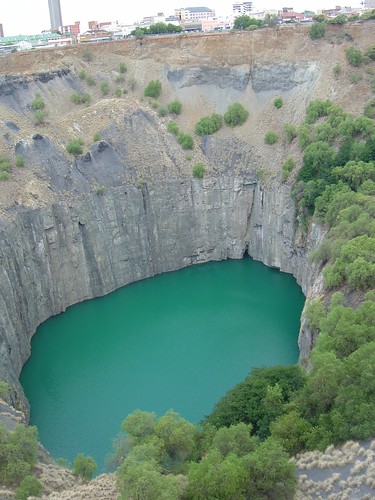Big Hole Kimberley South Africa (review)
In the end of the 19th century diamonds were found in South Africa. It all began when some kids playing near a river found a stone they liked and used it to play games with. Someone spotted the stone and verified it was a diamond.
An almighty diamond rush began. Until then it had believed diamonds were only to be found in South America and some parts of Asia,
At first all the diamond rush was centred on rivers in what is now the Free State area of South Africa as it was believed they came via rivers as they had only been found in or near them before.
Then diamonds were found away from a river in what became Kimberley. Thousands of stakes were made and many diamonds found. But they dried up and most gave up when they hit a hard blue like stone. Some clever men like Barnardo and Cecil John Rhodes bought up claims. It was then discovered that this hard blue like stone was where diamonds really were to be found.
It was the pipe created by volcanic eruptions that carried the diamonds that had been created by carbon and huge pressure to the surface. It had been erosion that had taken diamonds into rivers.
Although hard once the stone was wet and left in the sun it turns to a powder leaving diamonds behind.
The Big Hole in Kimberley is a monstrous huge hole that is the largest man made excavation in the world. It is surrounded by granite and the pipe with all the diamonds dug out. Looking at it, it is hard to imagine it was manmade. Especially when you find out it actually used to be a hill and so not only was the hill removed by so was the pipe. You can actually see the level where the original top soil would have been but the height of the land around it is so much higher from where all the material taken from the hole now lies.
The diamond pipe was removed by the late 1920s and most moved on to Johannesburg when gold was found. Considering the massive wealth that came from Kimberley (which meant that due to it was the first city in the world to have electric street lights and other innovations), it is now a small and somewhat poor looking and run down town.
Due to its location it is miles from any of the tourist routes and so gets few visitors as it is off the usual tracks and not a lot to see when there. De Beers still has its official head office here though, and holds its AGM here as well as having a massive diamond sorting operation here, but Kimberley is very much past its glory days.
The visitor centre and tour is interesting and they have built a very good replica village, but in reality you could do it all in an hour or so.
I am pleased to have seen it and heard the story. But as the story of diamonds and wealth and early examples of the white / black divide that came to dominate South Africa is quite sanitised through the experience I did feel that I had not got the full story. But will buy books to find out more, so not a bad outcome I guess!
In the vault at the end of the tour you see replica of the diamond that started it all, and other diamonds. But seeing replicas for me was kind of symbolic of what Kimberley has become.
To see all my photos of Kimberley: click here now













